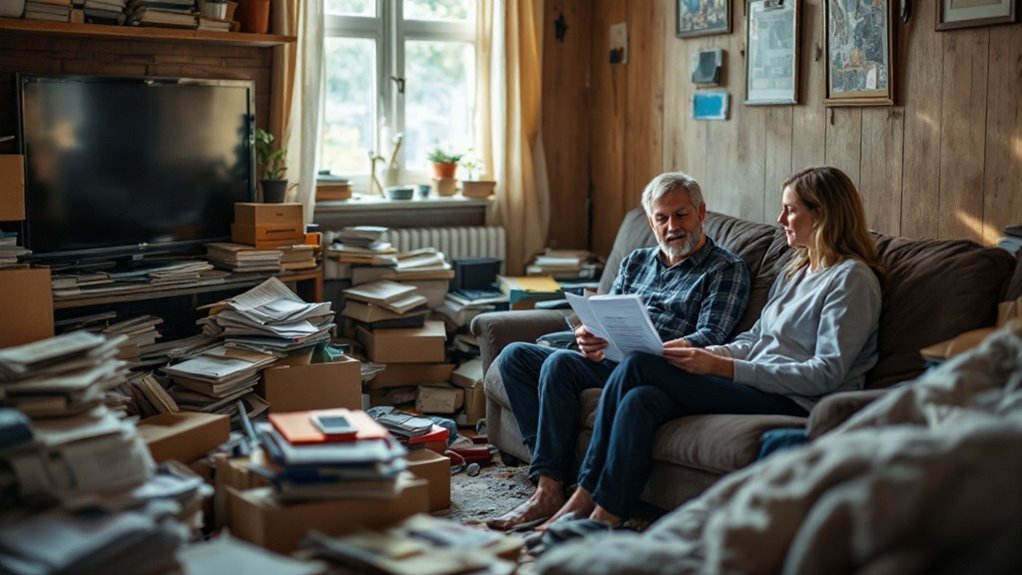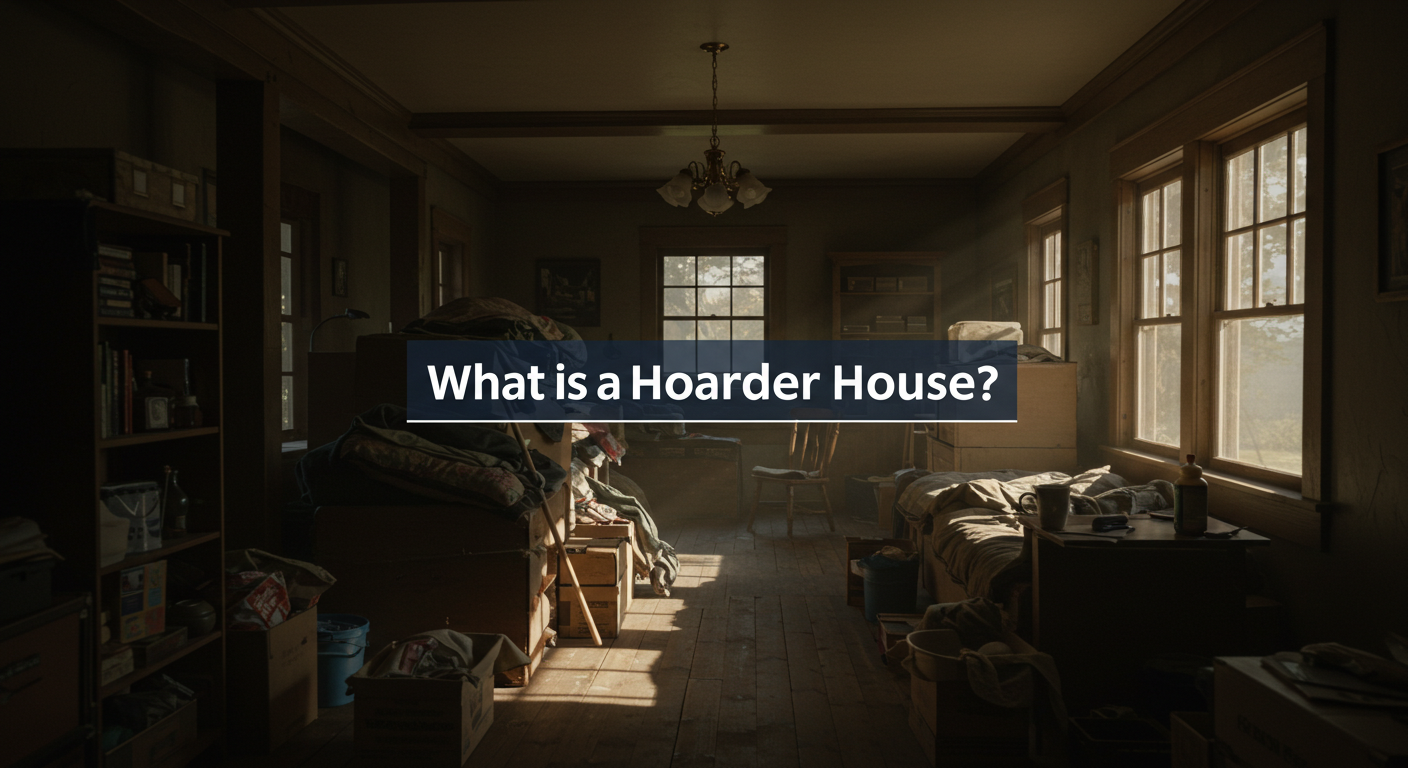A hoarder house is a living space overwhelmed by excessive clutter, where belongings accumulate to the point of rendering rooms unusable. You’ll often find narrow pathways, surfaces buried under items, and external areas like yards or garages filled with junk. This environment poses serious health risks, such as respiratory issues, pest infestations, and fire hazards due to blocked exits. Hoarding is often linked to psychological conditions like OCD or trauma, where emotional attachments to possessions hinder decision-making. Understanding the severity and causes can guide effective intervention. Exploring further will help you uncover strategies to address and manage these challenging situations.
Key Takeaways
- A hoarder house is characterized by excessive clutter, making living spaces nearly unusable and often extending to external areas like yards and garages.
- It is associated with hoarding disorder, a mental health condition linked to obsessive-compulsive tendencies and emotional attachments to possessions.
- Hoarder houses pose significant health risks, including unsanitary conditions, biohazards, and pest infestations, as well as safety hazards like fire risks.
- The severity of hoarding is categorized into five levels, ranging from minimal clutter to extreme accumulation requiring urgent intervention.
- Cleaning a hoarder house involves systematic junk disposal, disinfection, and often professional assistance for hazardous waste removal and structural repairs.
What is a Hoarder House
A hoarder house is a residence overwhelmed by an excessive accumulation of personal belongings, to the point where living spaces become nearly unusable. You’ll find that these homes are characterized by clutter that extends beyond typical disorganization, with surfaces like countertops, tables, and floors completely covered. This accumulation often leaves only narrow pathways for movement, severely impacting the functionality of the space. The clutter may also spill into external areas, such as yards, garages, or vehicles, further compounding the disarray.
The living conditions in a hoarder house are typically hazardous, posing risks to both physical and mental health. You might notice that the excessive clutter creates fire hazards, blocks exits, and fosters unsanitary environments. These conditions often stem from hoarding disorder, a mental health condition classified as an obsessive-compulsive disorder (OCD). Hoarding disorder involves persistent difficulty discarding possessions, regardless of their value, due to a perceived need to save them. This behavior is frequently tied to an intense emotional attachment to items, which can lead to significant distress when considering parting with them.
Understanding the definition of a hoarder house requires recognizing the interplay between the physical environment and the psychological factors driving the behavior. The emotional attachment to possessions often perpetuates the cycle of accumulation, making it challenging to address the underlying issues. By acknowledging the diagnostic criteria and the lived experience of those affected, you can better grasp the complexities of hoarding disorder and its impact on living conditions.
Common Characteristics of Hoarder Houses
Several distinct features often define hoarder houses, setting them apart from typical cluttered spaces. You’ll notice an overwhelming amount of junk, with items piled high and surfaces like countertops, tables, and floors completely obscured. These possessions often extend beyond the home’s interior, spilling into yards, garages, and even vehicles, creating a chaotic environment that disrupts daily functioning. The sheer volume of belongings leaves only narrow pathways for movement, making navigation difficult and unsafe.
The organization within hoarder houses is typically unique to the individual, reflecting personal significance rather than logical order. You might find broken appliances, outdated electronics, or sentimental items stored alongside everyday objects, many of which are damaged or unusable. This accumulation contributes to unsanitary conditions, as dust, mold, and pests often thrive in these environments. The inability to clean or maintain living spaces further exacerbates these issues, creating a cycle of clutter and neglect.
While the items themselves may hold emotional value to the individual, their excessive presence compromises the functionality of the home. Rooms intended for specific purposes, such as kitchens or bathrooms, may become inaccessible or unusable. This level of disarray not only impacts the individual’s quality of life but also raises concerns about health and safety. Understanding these common characteristics can help you recognize the challenges faced by those living in hoarder houses and the complexities of addressing the issue.
Health and Safety Risks in Hoarder Houses

While hoarder houses may appear as mere collections of possessions, they often harbor serious health and safety risks that can greatly impact those living within them. The unsanitary conditions created by excessive clutter, including dust, mold, and decaying organic matter, can lead to respiratory issues, allergies, and infections. You may find yourself exposed to biohazards like animal waste or rotting food, which further compromise your physical health and create a toxic living environment.
Fire hazards are another critical concern. The accumulation of flammable materials, such as paper, chemicals, and blocked escape routes, considerably increases the risk of fire spreading rapidly, endangering your safety. Additionally, pest infestations, including rodents and insects, thrive in these unsanitary conditions, posing risks of disease transmission and contamination.
The mental toll of living in a hoarder house can be equally severe. The overwhelming clutter and isolation often exacerbate existing mental health challenges, such as anxiety or depression, linked to hoarding behaviors. You may feel trapped by the environment, which can hinder your ability to seek help or maintain social connections, further deepening emotional distress.
Addressing these risks requires a compassionate, structured approach to improve both your physical and mental well-being. Recognizing the dangers is the first step toward creating a safer, healthier living space.
Levels of Hoarding Severity
You may notice Level 1 hoarding when minimal clutter is present, but living spaces remain functional and safe. At Level 2, clutter increases, odors become noticeable, and some areas lose their intended use, signaling a progression in severity. By Level 3, severe obstructions make rooms unusable, and trash accumulation creates significant challenges for daily living.
Level 1: Minimal Clutter
Although clutter is present in a Level 1 hoarder house, it doesn’t greatly disrupt daily life or the functionality of living spaces. You’ll notice minimal clutter in areas like countertops, floors, or furniture, but these spaces remain accessible and usable. The hoarder’s living spaces are generally clean, with no significant accumulation of dirt or grime. You won’t detect strong odors, as sanitary conditions are maintained, and there’s no evidence of pests or animal waste. This level reflects a manageable situation where the homeowner can still perform daily activities without major obstacles.
At this stage, the hoarder’s behavior may involve collecting items beyond what’s necessary, but it hasn’t escalated to the point of creating hazardous conditions. Cleanup efforts are typically straightforward, as the clutter hasn’t overwhelmed the environment. You might observe slight difficulty in organizing or discarding possessions, but the home remains safe and functional. Early intervention can help prevent progression to more severe levels. Recognizing these signs allows for timely support, ensuring the hoarder maintains a healthy living environment while addressing the underlying behaviors contributing to the clutter.
Level 2: Noticeable Odors
A Level 2 hoarder house marks a progression from minimal clutter to more pronounced challenges in maintaining a functional and sanitary living environment. At this stage, you’ll notice persistent odors, often caused by accumulated food waste, pet waste, or other organic materials. These odors are a clear indicator of an unsanitary environment, which can compromise both physical and mental health. The presence of animal waste or signs of rodent activity may also become more apparent, further exacerbating hygiene concerns. Hoarding behavior at this level often leads to cluttered living spaces, making it harder to perform basic tasks like cooking or cleaning. While the individual may begin to recognize the impact of their hoarding, addressing the issue can still feel overwhelming.
- Noticeable odors from food or pet waste permeate the home.
- Animal waste and potential rodent activity become visible.
- Living spaces lose functionality, complicating daily activities.
- The unsanitary environment poses health risks.
- Individuals may start acknowledging their hoarding behavior but struggle to take action.
At Level 2, the hoarder house begins to considerably impact quality of life, signaling the need for intervention to prevent further deterioration.
Level 3: Severe Obstructions
As hoarding behavior escalates to Level 3, severe obstructions begin to dominate the living environment, making it increasingly difficult to navigate or utilize spaces effectively. In a Level 3 hoarders house, clutter overwhelms rooms, often rendering them unusable and filled with overflowing trash. Visible signs of neglect, such as animal waste and rodent activity, indicate a significant decline in living conditions. These factors not only compromise hygiene but also exacerbate mental health challenges, as the individual may experience heightened emotional distress, anxiety, and social isolation due to the overwhelming environment.
Safety hazards become a critical concern at this stage. Blocked pathways and exits create risks during emergencies, such as fires, while the accumulation of debris can lead to structural instability. The clutter may also harbor mold, pests, or other health risks, further endangering the resident. Professional intervention is typically necessary at Level 3, as the severity of the situation often exceeds the individual’s ability to manage it alone. Addressing these issues requires a compassionate, structured approach to guarantee both physical safety and mental health support.
Causes and Psychological Factors of Hoarding

You may develop hoarding behaviors due to emotional attachments to possessions, often believing they hold sentimental or future value. Trauma or significant stress, such as loss or major life changes, can trigger these behaviors as a coping mechanism. Additionally, mental health conditions like OCD, ADHD, or depression frequently co-occur with hoarding, complicating your ability to manage possessions effectively.
Emotional Attachment to Possessions
Emotional attachment to possessions often lies at the heart of hoarding disorder, shaping how individuals perceive and interact with their belongings. You may find that personal items become extensions of your identity, making it difficult to part with them, even when they no longer serve a practical purpose. This intense emotional attachment can stem from cognitive distortions, where you believe these items hold future value or are tied to cherished memories. For individuals with compulsive hoarding, the thought of discarding possessions can trigger anxiety, fear of loss, or feelings of emptiness, often linked to underlying mental disorders like depression or anxiety.
- Identity and Belongings: Personal items may feel like part of your self-worth or identity.
- Cognitive Distortions: Believing items will be needed later or hold future significance.
- Memory Associations: Objects tied to memories or relationships become irreplaceable.
- Emotional Distress: Discarding items can evoke feelings of loss or anxiety.
- Underlying Mental Health: Anxiety or depression may intensify attachment to possessions.
Understanding these psychological factors is vital for addressing hoarding behaviors with empathy and care.
Trauma and Stress Triggers
While trauma and stress can profoundly impact mental health, they often serve as significant triggers for hoarding behaviors. When you experience trauma, such as the loss of a loved one or a major life upheaval, it can disrupt your emotional stability, leading to an overwhelming need to hold onto possessions as a source of comfort or control. Stressful events, like divorce or job loss, may also amplify this behavior, as you might accumulate items to create a sense of security in an otherwise chaotic environment. These experiences can exacerbate feelings of social isolation, further deepening your reliance on possessions for emotional support. The inability to discard items often stems from cognitive distortions, such as fearing future regret or believing objects hold intrinsic value. This pattern can become self-reinforcing, as the clutter itself generates additional stress, creating a cycle that’s difficult to break. Understanding these triggers is essential, as they highlight the complex interplay between emotional distress and hoarding tendencies, offering insight into the psychological factors driving this behavior.
Mental Health Conditions Link
Hoarders often struggle with underlying mental health conditions that shape their relationship with possessions. Conditions like obsessive-compulsive disorder (OCD), anxiety, and depression frequently co-occur with hoarding, influencing how you perceive and interact with clutter. These mental health conditions can amplify emotional attachments to items, making it difficult to discard even seemingly insignificant objects. Cognitive distortions, such as overestimating an item’s future value, further reinforce the accumulation of clutter, creating overwhelming living spaces.
- Obsessive-Compulsive Disorder (OCD): Many hoarders exhibit OCD-like behaviors, such as intrusive thoughts about discarding items or excessive worry about losing something important.
- Anxiety Disorders: Anxiety often drives the need to hold onto possessions as a source of comfort or security.
- Depression: Feelings of hopelessness or low energy can make it harder to organize or declutter, leading to stagnation.
- Cognitive Distortions: You might believe items are irreplaceable or will be needed later, even when evidence suggests otherwise.
- Social Isolation: Shame about your living conditions can lead to withdrawal, reducing access to support systems that could help manage hoarding behaviors.
Understanding these mental health conditions is essential for addressing the root causes of hoarding and developing effective treatment strategies.
How to Clean and Address a Hoarder House
Cleaning and addressing a hoarder house requires a structured, methodical approach to guarantee both safety and effectiveness. Begin with a thorough assessment to evaluate the severity of the clutter, which often includes hazardous conditions such as rotting food, animal waste, or structural damage. If the individual has been living alone, the accumulation of items may have created biohazards, necessitating specialized hoarding cleanup protocols. Prioritize safety by wearing protective gear, including gloves, masks, and sturdy footwear, to minimize exposure to contaminants.
Systematic junk disposal is essential. Start by categorizing items into trash, donations, and keepables. Discard rotting food, broken items, and anything unsalvageable immediately. For usable items, consider donating to reduce clutter and support the individual’s shift to a healthier living environment. Disinfection is critical, especially in areas affected by organic waste or mold. Use EPA-approved cleaning agents to sanitize surfaces and eliminate pathogens.
In severe cases, professional assistance may be required. Hazardous waste removal services can safely handle biohazards, while structural repairs address damage caused by prolonged neglect, such as plumbing issues or weakened floors. These steps guarantee the home is not only clean but also functional and safe for habitation. Throughout the process, maintain an empathetic tone, recognizing the emotional challenges tied to hoarding. A diagnostic focus helps identify underlying issues, guaranteeing the cleanup addresses both the physical and psychological aspects of the condition.
Resources and Support for Hoarding Disorder

Addressing hoarding disorder extends beyond cleaning and organizing a cluttered space; it involves accessing resources and support systems to tackle the underlying psychological and emotional challenges. Hoarding disorder is a complex mental health condition that often requires a multifaceted approach to treatment. Cognitive-behavioral therapy (CBT) is the most evidence-based intervention, helping you identify and modify the thought patterns and behaviors that sustain hoarding. A therapist trained in CBT can guide you through structured exercises to reduce distress and improve decision-making around possessions.
Support groups provide a safe, nonjudgmental environment where you can share experiences and learn coping strategies from others facing similar struggles. These groups foster a sense of community and reduce feelings of isolation. Professional organizing services can also play a critical role, offering hands-on assistance to declutter and reorganize your living space in a way that aligns with your goals. These professionals often work alongside mental health providers to guarantee a compassionate and effective approach.
Local agencies and organizations, such as the International OCD Foundation, can connect you with additional resources, including treatment referrals and educational materials. Reaching out for help is a courageous step, and these resources are designed to support you throughout your journey.
- Cognitive-behavioral therapy (CBT): Targets thought patterns and behaviors linked to hoarding.
- Support groups: Provide community and shared coping strategies.
- Professional organizing services: Assist with decluttering and restructuring spaces.
- Local agencies: Offer referrals and educational resources.
- Online resources: Access information and treatment options from trusted organizations.
Conclusion
If you’re maneuvering through a hoarder house, remember it’s a labyrinth of both physical clutter and emotional weight. Addressing it requires patience, understanding, and professional support. Hoarding disorder isn’t just about objects—it’s a reflection of deeper psychological struggles. By approaching the situation with empathy and structured intervention, you can help untangle the chaos, restoring safety and well-being. Healing begins when the clutter clears, but the journey is as much about the mind as the mess.




